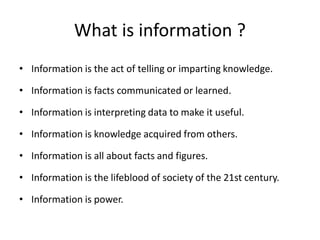Characteristics of information
- 1. Characteristics of Information TRIBHUVAN UNIVERSITY Department: Library & Information Science Class: (MLIS) Paper: Library & Society Unit No. 7Mahendra Prasad Adhikari Roll. 20 Origin /source Message Medium Recipient Presented By:
- 2. What is information ? • Information is the act of telling or imparting knowledge. • Information is facts communicated or learned. • Information is interpreting data to make it useful. • Information is knowledge acquired from others. • Information is all about facts and figures. • Information is the lifeblood of society of the 21st century. • Information is power.
- 3. Types of information • News • Ideas and opinions • Research results • Routine information, like flight timetable, phone numbers, maps, etc. • History or background information • Fact and figures • Technical information • Legal information , etc. • Documentary/ Non-documentary, Audio/ video
- 4. Characteristics of information • Comprehensiveness /Understandable: • Relevant/Appropriateness: • Completeness: • Availability / Accessibility: • Reliability: (Reasonable) • Concise: (not more/ not less) • Timeliness: (not delay) • Flexibility:(easy to change suitable form) • Explicitness: (no need to analysis) • Biasfree / Impartiality: • Validity/ authentic • Fact / Accuracy • Verifiability • Currency / current / updated • Breadth of coverage • Format • Medium • Communicability • Recipient • Adaptability • Cost-effectiveness: Origin /source Message Medium Recipient
- 5. Nature of information • Approaches to information – Structural approach – Knowledge approach – Message approach • Nature by kind – Semantic information (as a message) – Semantic information ( as a process) – Documentary information • Nature base on users’ approach • Commodity approach – Commodity – Process – State of knowing – Environment
- 6. Natural Characteristics of information 1. Exponential Growth a. Doubling of Knowledge 2. Information is cumulative a. Gathering of information b. Storing information c. Application d. Generating information 3. Information is inter-disciplinary a. Typology of inter-disciplinary 4. Information is scatter a. In related and unrelated disciplines b. Utility in relation to scatter 5. Information is a resource for future a. A natural resource b. Information is the major criterion c. Information is a commodity
- 7. Understandable: Since information is already in a summarized form, it must be understood by the receiver so that he will interpret it correctly. He must be able to decode any abbreviations, shorthand notations or any other acronyms contained in the information.
- 8. Relevant: • Information is good only if it is relevant. This means that it should be pertinent and meaningful to the decision maker and should be in his area of responsibility.
- 9. Complete: It should contain all the facts that are necessary for the decision maker to satisfactorily solve the problem at hand using such information. Nothing important should be left out. Although information cannot always be complete, every reasonable effort should be made to obtain it.
- 10. Available: Information may be useless if it is not readily accessible ‘ in the desired form, when it is needed. Advances in technology have made information more accessible today than ever before.
- 11. Reliable: The information should be counted on to be trustworthy. It should be accurate, consistent with facts and verifiable. Inadequate or incorrect information generally leads to decisions of poor quality. For example, sales figures that have not been adjusted for returns and refunds are not reliable.
- 12. Concise: Too much information is a big burden on management and cannot be processed in time and accurately due to “bounded rationality”. Bounded rationality determines the limits of the thinking process which cannot sort out and process large amounts of information. Accordingly, information should be to the point and just enough – no more, no less.
- 13. Timely: • Information must be delivered at the right time and the right place to the right person. Premature information can become obsolete or be forgotten by the time it is actually needed. • Similarly, some crucial decisions can be delayed because proper and necessary information is not available in time, resulting in missed opportunities. Accordingly the time gap between collection of data and the presentation of the proper information to the decision maker must be reduced as much as possible.
- 14. Cost-effective: The information is not desirable if the solution is more costly than the problem. The cost of gathering data and processing it into information must be weighed against the benefits derived from using such information.
- 15. Flexibility: The business and economic environment is highly dynamic in nature. Technological changes occur very fast. A rigid control system would not be suitable for a changing environment. These changes highlight the need for flexibility in planning as well as in control.
- 16. Explicitness: • Information is said to be of good quality if it does not require further analysis by the recipients for carrying out their activities.
- 17. Bias / Impartiality: • Impartial information contains no bias and has to be collected without any distorted view of the situation.
















